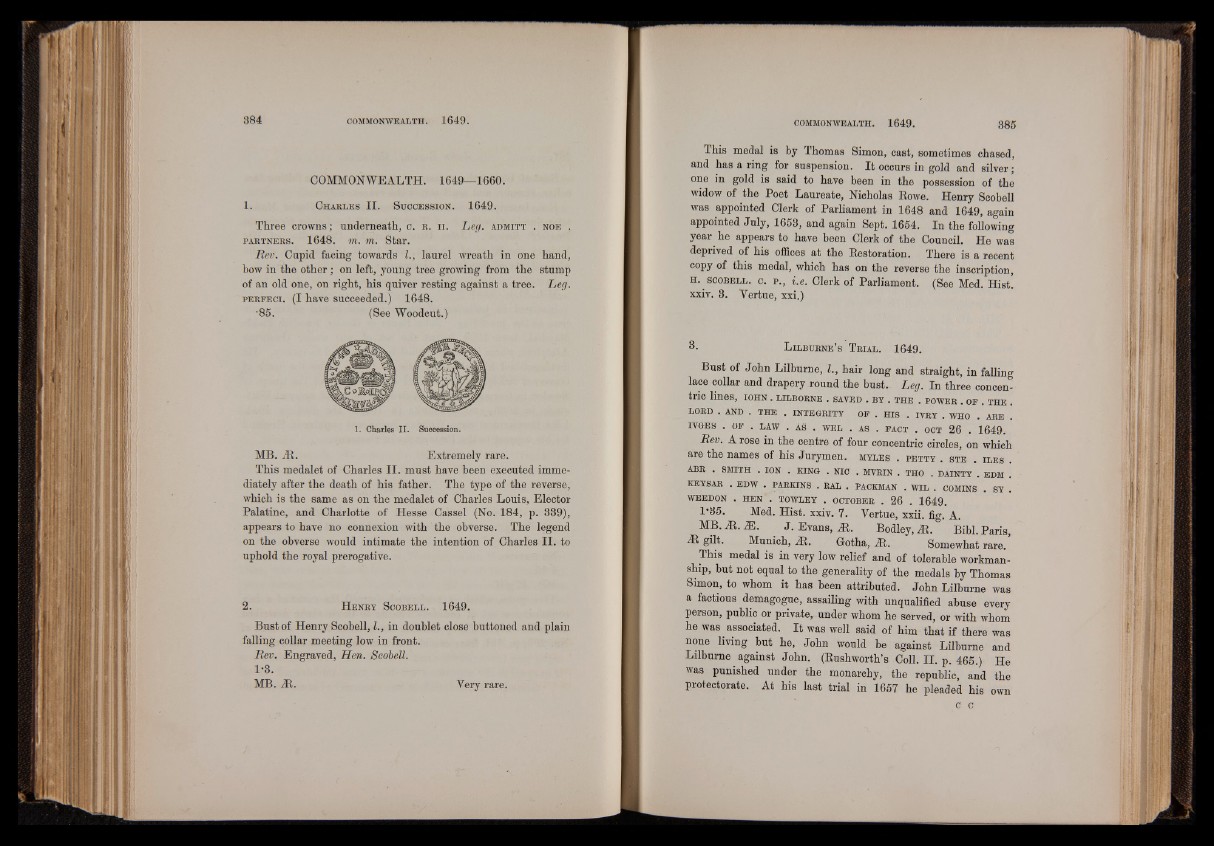
COMMONWEALTH. 1649—1660.
1. C h a r l e s II. S u c c e s s io n . 1649.
Three crowns; underneath, c. R. n. Leg. a dm it t . n o e ,
p a r t n e r s . 1648. m . m . Star.
Rev. Cupid facing towards I., laurel wreath in one hand,
bow in the other; on left, young tree growing from the stump
of an old one, on right, his quiver resting against a tree. Leg.
p e r f e c i . (I have succeeded.) 1648.
•85. (See Woodcut.)
1. Charles II. Succession.
MB. M. Extremely rare.
This medalet of Charles II. must have been executed immediately
after the death of his father. The type of the reverse,
which is the same as on the medalet of Charles Louis, Elector
Palatine, and Charlotte of Hesse Cassel (No. 184, p. 339),
appears to have no connexion with the obverse. The legend
on the obverse would intimate the intention of Charles II. to
uphold the royal prerogative.
2. H e n r y S c o b e l l . 1649.
Bust of Henry Scobell, L, in doublet close buttoned and plain
falling collar meeting low in front.
Rev. Engraved, Hen. Scobell.
1-3.
This medal is by Thomas Simon, cast, sometimes chased,
and has a ring for suspension. It occurs in gold and silver;
one in gold is said to have been in the possession of the
widow of the Poet Laureate, Nicholas Rowe. Henry Scobell
was appointed Clerk of Parliament in 1648 and 1649, again
appointed July, 1653, and again Sept. 1654. In the following
year he appears to have been Clerk of the Council. He was
deprived of his offices at the Restoration. There is a recent
copy of this medal, which has on the reverse the inscription,
h . s c o b e l l . c. p ., i.e. Clerk of Parliament. (See Med. Hist,
xxiv. 3. Yertue, xxi.)
3- L il b u r n e ’s T r ia l . 1649.
Bust of John Lilburne, I., hair long and straight, in falling
lace collar and drapery round the bust. Leg. In three concentric
lines, IOHN . LILBORNE . SAVED . BY . THE . POWER . OF . THE .
LORD . AND . THE . INTEGRITY OF . HIS . IVRY . WHO . ARE .
IVGES . OF . LAW . AS . WEL . AS . FACT . OCT 26 . 1649.
Rev. A rose in the centre of four concentric circles, on which
are the names of his Jurymen, m y l e s . p e t t y . s t e . il e s
ABB . SMITH . ION . KING . NIC . MVRIN . THO . DAINTY . EDM .
KEYSAR . EDW . PARKINS . RAL . PACKMAN . WIL . COMINS . SY .
WEEDON . HEN . TOWLEY . OCTOBER . 26 . 1649.
1’35. Med. Hist. xxiv. 7. Yertue, xxii. fig. A.
MB.At.iE. J . Evans, At. Bodley, At. Bibl. Paris,
-St gilt. Munich, At. Gotha, At. Somewhat rare.
This medal is in very low relief and of tolerable workmanship,
but not equal to the generality of the medals by Thomas
Simon, to whom it has been attributed. John Lilburne was
a factious demagogue, assailing with unqualified abuse every
person, public or private,, under whom he served, or with whom
he was associated. It was well said of him that if there was
none living but he, John would be against Lilburne and
Lilburne against John. (Rushworth’s Coll. II. p. 465.) He
was punished under the monarchy, the republic, and the
protectorate. At his last trial in 1657 he pleaded his own
c c